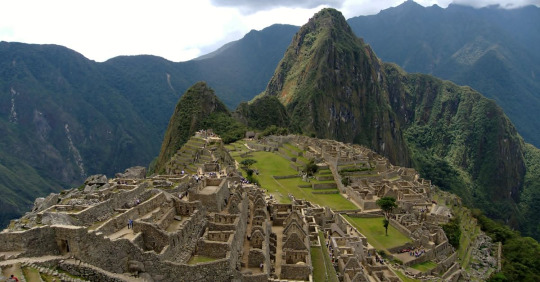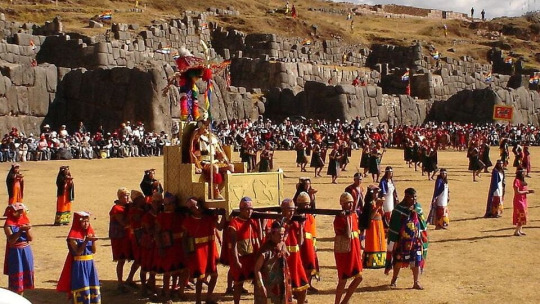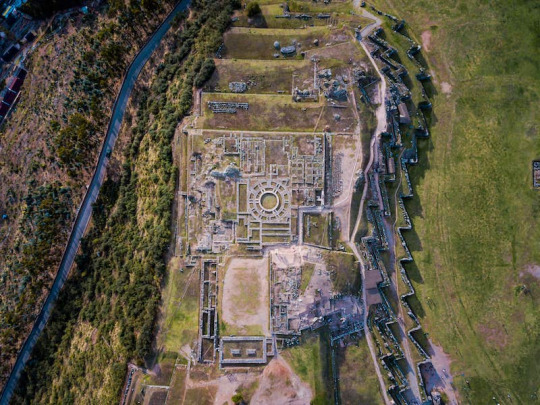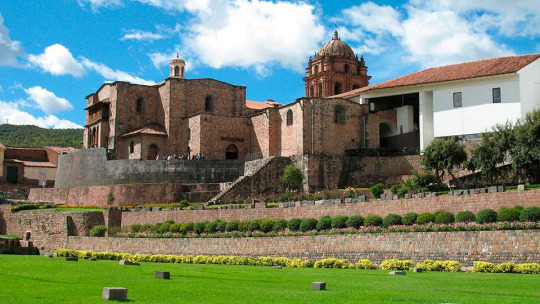Text
Machu Picchu

Hello and welcome to my travel vlog! Today, we are going to explore one of the most fascinating wonders of the world - Machu Picchu. This ancient Incan city is located high up in the Andes Mountains, and was built in the 15th century.
As we make our way up the steep mountain trails, we can see the lush greenery and beautiful waterfalls cascading down the cliffs. The air is thin, and our legs are tired, but the stunning scenery makes it all worth it.
Finally, we reach the top of the mountain, and the sight that greets us takes our breath away. Machu Picchu is spread out before us, with its magnificent stone structures and terraced hillsides. The view is truly awe-inspiring.
We explore the various buildings and structures, including the Temple of the Sun, the Sacred Plaza, and the Intihuatana stone. The intricate stonework and precision engineering of the Incas is truly remarkable, and we can't help but wonder how they were able to build such a complex city without the use of modern technology.
As we wander around the city, we come across llamas grazing on the terraced hillsides, and local Incan people going about their daily business. We can't help but feel a sense of connection to the ancient people who once called this city their home.
More Details:
Machu Picchu is an ancient Incan city located in the Andes Mountains of Peru. Built in the 15th century, it was abandoned during the Spanish conquest and remained hidden until its rediscovery in 1911 by Hiram Bingham, an American archaeologist. The city is believed to have been a sacred site and retreat for Incan rulers, as well as a center for astronomical observations and agricultural production.The city is located on a steep mountain ridge and is made up of over 200 structures, including temples, residences, and plazas. The buildings are constructed using intricate stonework, with no mortar or cement used in their construction. The terraced hillsides surrounding the city were used for agricultural production, and water was supplied through an intricate network of canals and aqueducts. Machu Picchu was designated as a UNESCO World Heritage site in 1983 and attracts thousands of visitors each year. However, concerns have been raised about the impact of tourism on the site, and measures have been taken to limit the number of visitors and preserve the fragile ecosystem. Despite the passage of time, Machu Picchu remains an important cultural and historical site, providing insights into the architecture, engineering, and agricultural practices of the ancient Incan civilization. Its beauty and mystery continue to captivate visitors from around the world.
0 notes
Text
Inti Raymi

Welcome to the Inti Raymi, one of the most significant festivals of the Incan civilization, celebrated every year on the 24th of June.The Inti Raymi, also known as the Festival of the Sun, takes place in the historic city of Cusco, Peru. It's a celebration of the winter solstice and a tribute to the Incan sun god, Inti. The festival lasts for nine days, with the main event taking place on the 24th of June, the day of the winter solstice.
As we arrive in Cusco, we can feel the excitement and anticipation in the air. The streets are lined with people dressed in traditional Incan clothing, and the city is decorated with bright colors and elaborate decorations. We make our way to the main plaza, where the ceremony is about to begin.
The ceremony starts with a procession of Incan priests, led by Sapa Inca, the emperor of the Incan empire. They carry offerings and symbols of the Incan civilization, such as golden plates and llamas. The procession moves towards the sacred temple of the sun, where the main ceremony takes place.
As we follow the procession, we can hear the sound of traditional music and see the colorful dances of the Incan people. The energy is contagious, and we find ourselves dancing along with the locals.
Once we arrive at the temple of the sun, the ceremony begins. The Sapa Inca offers his thanks to the sun god, Inti, and prays for a good harvest in the coming year. The priests perform a ritual sacrifice of a llama, which is believed to bring good fortune to the people.
As the ceremony comes to an end, we feel a sense of awe and wonder at the ancient traditions that we've witnessed. We take in the stunning views of the Andes Mountains and the city of Cusco, feeling grateful to have experienced this incredible celebration.
More Details:
The Inti Raymi is a traditional celebration that has been held in Cusco, Peru, for centuries. It is one of the most important cultural events in Peru, and it is recognized as a UNESCO Intangible Cultural Heritage. The festival is celebrated every year on June 24th, coinciding with the winter solstice in the southern hemisphere. It is a celebration of the sun god Inti and marks the beginning of a new agricultural year. The celebration begins with a procession from the Qorikancha temple to the Plaza de Armas in Cusco. The procession is led by the Sapa Inca, who is carried on a golden litter, followed by high priests and other dignitaries. Once the procession reaches the Plaza de Armas, the ceremony begins with a prayer to the sun god, Inti. The Sapa Inca then performs a symbolic ritual that involves planting the first crops of the new year. This ritual is believed to bring good fortune and a bountiful harvest. The climax of the ceremony is the sacrifice of a llama. The llama is selected for its purity and is believed to be a sacred animal. The llama is then sacrificed, and its blood is sprinkled on the ground as an offering to the gods. The Inti Raymi is a unique opportunity to witness the ancient traditions and cultural heritage of the Incan civilization.
1 note
·
View note
Text
Sacsayhuaman

Next stop we're going to explore Sacsayhuaman, a fortress located in the city of Cusco, Peru. As we approach the site, we're struck by the massive stone walls that make up the fortress. The stones are huge and fit together perfectly, without any mortar. It's hard to believe that these were built by hand, without modern technology.
We enter through one of the gateways and find ourselves in a large courtyard, surrounded by even more impressive stone walls. We can see the ruins of houses and other buildings around us, evidence of the people who once lived and worked here.
As we walk through the fortress, we can feel the weight of history all around us. We imagine what life must have been like for the Inca people who built and lived here so long ago. We can almost hear the sounds of their daily lives, the clatter of tools, and the bustle of people going about their business.
We come to a section of the fortress that overlooks the city of Cusco below. The view is breathtaking, and we can see why the Inca chose this location to build their fortress. From up here, they would have had an excellent view of any enemies approaching the city.
As we continue to explore, we come across a temple dedicated to the Inca god, Viracocha. The temple is smaller than we expected, but the stone carvings and decorations are incredibly intricate and beautiful.
We spend several hours wandering through the fortress, marveling at the ingenuity and skill of the Inca people who built it. As the sun starts to set, we make our way back to the entrance, feeling humbled and awed by the experience.
More Details:
Sacsayhuaman is an Incan fortress located on a hill overlooking the city of Cusco, Peru. It was constructed during the reign of the Inca emperor Pachacuti in the 15th century and is considered to be one of the most impressive examples of Incan architecture and engineering. The fortress is built of massive stones, some of which weigh over 100 tons, and it is believed that the stones were transported from a quarry several miles away. The precision with which the stones were cut and fitted together is truly remarkable, and the fact that they have remained in place for over 500 years is a testament to the ingenuity of the Incan builders. Sacsayhuaman was not just a fortress; it was also a religious site, and it was home to several temples and shrines dedicated to Incan gods. The largest of these was the temple of the sun, which was said to be covered in gold and silver. The fortress played a significant role in Incan history and was the site of several important battles, including the Battle of Cusco in 1536, during which the Inca resistance was defeated by the Spanish conquistadors. Today, Sacsayhuaman is a popular tourist attraction and is considered to be one of the most important archaeological sites in Peru. Visitors can explore the ruins of the fortress, marvel at the precision of the stonework, and learn about the rich history of the Inca people.
0 notes
Text
Ollantaytambo

Welcome to Ollantaytambo, an Incan town nestled in the heart of the Andes Mountains. As we approach Ollantaytambo, we are greeted by the towering stone walls that surround the town. These walls were built by the Incas and were designed to protect the town from invaders. We can see the soldiers guarding the walls and keeping watch for any potential threats.
As we enter the town, we are struck by the incredible architecture of the buildings. The Incas were master builders and their structures were built to withstand the harsh Andean climate. The buildings are made of stone and are arranged in a grid pattern.
We walk down the narrow streets of Ollantaytambo and see the locals going about their daily business. We see women weaving colorful fabrics and men tending to their crops. The Incas were known for their advanced agricultural techniques, and the fertile land surrounding Ollantaytambo allowed them to grow a variety of crops.
As we make our way to the center of town, we see the magnificent temple of the sun. This temple was built to honor the Incan sun god, Inti. The temple is adorned with gold and precious stones, and its walls are covered in intricate carvings.
We also see the terraced fields that surround the town. These terraces were built by the Incas to help prevent erosion and increase the amount of arable land available for agriculture. The terraces are still in use today, and we can see farmers tending to their crops.
As the sun begins to set, we make our way to the top of the nearby hill to watch the sunset. From here, we have a breathtaking view of the town and the surrounding mountains. We can see the ruins of an Incan fortress perched high on a nearby mountain, a reminder of the town's strategic importance.
As our day in Ollantaytambo comes to a close, we are struck by the incredible beauty and sophistication of this Incan town. The Incas were a remarkable people, and their legacy can still be seen and felt in Ollantaytambo today.
More Details:
Ollantaytambo is a town located in the Sacred Valley of the Incas, in the Cusco region of Peru. It is situated at an elevation of 2,792 meters above sea level and is surrounded by towering mountains and fertile valleys. The town was originally built by the Incas in the 15th century as a military, agricultural, and religious center. The town is known for its impressive stone structures, including the fortress of Ollantaytambo, which sits atop a hill overlooking the town. The fortress was built by the Incas to protect against invading armies and is a testament to the advanced engineering and architectural skills of the Incas. In addition to the fortress, Ollantaytambo is home to several other important Incan ruins, including the Temple of the Sun and the Royal Storehouses. The town is also known for its well-preserved Incan street grid and irrigation systems, which are still in use today. Today, Ollantaytambo is a popular tourist destination and a starting point for many hikes and treks in the surrounding mountains. The town is also a hub for the famous Inca Trail to Machu Picchu, which starts in the nearby town of Piscacucho.
0 notes
Text
Coricancha

Welcome to Coricancha, one of the most important temples in the Inca Empire. As we walk towards the temple, we see its golden walls shining in the sunlight. This magnificent structure was built in the 15th century and was dedicated to the sun god Inti.
As we enter the temple, we see the walls adorned with gold and silver, and the floors paved with precious stones. The temple was a center of worship and a place of great significance to the Inca people.
The main courtyard of the temple was surrounded by various rooms, each dedicated to different gods and goddesses. The rooms were decorated with beautiful textiles, ceramics, and intricate carvings.
As we walk through the temple, we can hear the sound of music and chanting. The Inca people believed that the sun god Inti could hear their prayers, and they would offer him gifts of gold and silver.
One of the most remarkable features of Coricancha was the astronomical observatory located on the roof. The Inca people were expert astronomers and used this observatory to track the movement of the stars and planets. The knowledge they gained from their observations helped them to develop their calendar and predict seasonal changes.
The temple was also a center of learning and knowledge. The Inca people had a system of writing called quipus, which consisted of colored strings and knots. They used this system to record their history, laws, and other important information.
As we leave the temple, we feel a deep sense of awe and wonder. The beauty and sophistication of Coricancha are a testament to the ingenuity and creativity of the Inca people. It is a reminder of the rich cultural heritage that they have left behind, and a testament to the power of human imagination and ingenuity.
More Details:
Coricancha, also known as the "Temple of the Sun," was one of the most important religious centers of the Inca Empire, located in the heart of Cusco, Peru. It was built during the reign of the Inca ruler Pachacuti in the mid-15th century and was considered a masterpiece of Inca engineering and architecture. The temple was dedicated to the sun god Inti, who was considered the most important deity in Inca religion. Its walls were covered with sheets of gold, and its interior was adorned with silver and precious stones. The temple's courtyard was surrounded by rooms dedicated to different gods and goddesses, each decorated with intricate carvings, textiles, and ceramics. One of the most fascinating features of Coricancha was its astronomical observatory, located on the temple's rooftop. The Inca people were skilled astronomers and used this observatory to study the movements of the stars and planets. They used their knowledge to develop their calendar, which was highly accurate and helped them to predict seasonal changes. Despite the Spanish conquest of Peru in the 16th century, the temple remains a significant symbol of Inca culture and heritage. Today, visitors can still see the remnants of the temple's magnificent architecture and learn about the rich history and religious beliefs of the Inca people.
0 notes
Text
Works Cited
"Betanzos, Juan de." Early Civilizations in the Americas Reference Library, edited by Sonia G. Benson, et al., vol. 3: Biographies and Primary Sources, UXL, 2005, pp. 21-31. Gale In Context: World History, link.gale.com/apps/doc/CX3424400058/WHIC?u=viva2_nvcc&sid=bookmark-WHIC&xid=c6cd9c97. Accessed 6 Apr. 2023.
"Civilizations and Empires of the Americas--Early Civilizations of the Andes." Gale World History Online Collection, Gale, 2021. Gale In Context: World History, link.gale.com/apps/doc/KDBMLH695681028/WHIC?u=viva2_nvcc&sid=bookmark-WHIC&xid=29e03fd3. Accessed 8 Apr. 2023.
Currie, Robin. “Couriers in the Inca Empire: Getting Your Message Across.” NEH, 10 July 2019, https://edsitement.neh.gov/lesson-plans/couriers-inca-empire-getting-your-message-across. Accessed 8 Apr. 2023.
Dhwty. “The Inca Empire: What Made It so Powerful?” Ancient Origins Reconstructing the Story of Humanity's Past, Ancient Origins, 27 May 2020, https://www.ancient-origins.net/ancient-places-americas/inca-empire-0012840.
“Inti Raymi – the Festival of the Sun.” TreXperience, https://trexperienceperu.com/blog/inti-raymi. Accessed 7 Apr. 2023.
Julien, Catherine. "Daily Life in the Inca Empire." Journal of Social History, vol. 31, no. 3, spring 1998, pp. 744+. Gale In Context: World History, link.gale.com/apps/doc/A20574164/WHIC?u=viva2_nvcc&sid=bookmark-WHIC&xid=3759b52d. Accessed 7 Apr. 2023.
"Poma de Ayala, Felipe Huaman." Early Civilizations in the Americas Reference Library, edited by Sonia G. Benson, et al., vol. 3: Biographies and Primary Sources, UXL, 2005, pp. 63-71. Gale In Context: World History, link.gale.com/apps/doc/CX3424400062/WHIC?u=viva2_nvcc&sid=bookmark-WHIC&xid=f3f12c12. Accessed 7 Apr. 2023.
Sío-López, Cristina Blanco. "Inca Empire." Encyclopedia of Western Colonialism since 1450, edited by Thomas Benjamin, vol. 2, Macmillan Reference USA, 2007, pp. 597-600. Gale In Context: World History, link.gale.com/apps/doc/CX2587300212/WHIC?u=viva2_nvcc&sid=bookmark-WHIC&xid=2328ad8c. Accessed 8 Apr. 2023.
Tavani, Claudia. “A Useful Guide to Visiting Sacsayhuaman, Cusco.” My Adventures Across The World, 28 Nov. 2022, https://myadventuresacrosstheworld.com/sacsayhuaman-cusco-ruins-guide/. Accessed 8 Apr. 2023.
“The Coricancha Temple in Cusco: Blog Machu Travel Peru.” Peru Travel Blog | Machu Travel Peru, 26 Apr. 2022, https://www.machutravelperu.com/blog/coricancha. Accessed 8 Apr. 2023.
1 note
·
View note